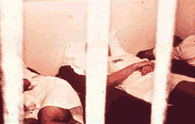 |
 |
 |
 |
This is what one of our guards looked like. All guards were dressed in identical uniforms of khaki, and they carried a whistle around their neck and a billy club borrowed from the police. Guards also wore special sun-glasses, an idea I borrowed from the movie "Cool Hand Luke." Mirror sunglasses prevented anyone from seeing their eyes or reading their emotions, and thus helped to further promote their anonymity. We were, of course, studying not only the prisoners but also the guards, who found themselves in a new power-laden role.
We began with nine guards and nine prisoners in our jail. Three guards worked each of three eight-hour shifts, while three prisoners occupied each of the three barren cells around the clock. The remaining guards and prisoners from our sample of 24 were on call in case they were needed. The cells were so small that there was room for only three cots on which the prisoners slept or sat, with room for little else.

|
 |



 |
|
 |
 |
 |







